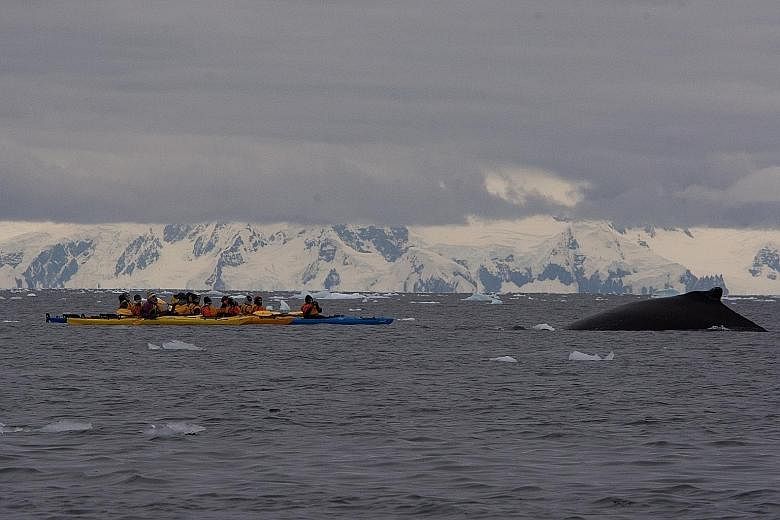We christen three passing humpback whales, while exploring Antarctica in style.
Oreo, Raven and Mariposa are humpback whales, new to scientists, that guests on our expedition ship are invited to name, based on their splendid tails that are as unique as fingerprints.
For instance, Oreo, with a black-and-white tail or fluke, is named for the beloved American chocolate cookie with a sweet cream filling.
Some guests have been able to photograph the whale tails on our voyage.
En route, from our Wi-Fi-enabled ship, the Hebridean Sky, the photos are whizzed to the Oregon-based Happywhale project that monitors whales globally, for fun and science.
Happywhale soon confirms that our three marine mammals have been identified for the first time, so we have the right to choose their names.
Photo-identification - when whales are snapped and tracked - makes it possible to gather data on their migration and other behaviour.
BEAUTIFUL SCIENCE
In Antarctica, travellers turn citizen scientists, supporting experts in the scrutiny of wildlife, clouds, climate-change triggers and other phenomena.
From the deck, I count sea birds such as storm petrels and albatrosses for the Cornell Lab of Ornithology and National Audubon Society, which study bird abundance and whereabouts.
I also start a momentary bond with Nasa, the National Aeronautics and Space Administration, by observing clouds for its climatology project, using an app.
Other guests collect water samples to help expose the extent of microplastics pollution, and volunteer for another half-dozen duties. Crowd-sourcing, like elsewhere, is cool in Antarctica.
We revel in our role and also the life of luxury on our small, all-suite ship that is chartered by Vermont-based Polar Latitudes.
LIFE ON POLAR SHIP
The 90.5m-long ship, built for adventure with an ice-strengthened hull and stabilisers to reduce rolling, is also elegant and run like a resort with butler services.
Last year, it was refitted at a cost of US$10 million (S$13.6 million).
Hot chocolate spiked with amaretto is served when 100 chilly guests return from island treks and Zodiac cruises.
There is camaraderie, born from a shared excitement about far-flung places, when guests dine and wine informally, no gowns in sight.
I encounter an Israeli physicist, a Hollywood agent, a Human Genome Project pharmacist, a retired French technician, North American techies and oil riggers, elderly Japanese women and a New Zealand business strategist working remotely in South America who starts a Facebook group as nobody wants the adventure to end.
Every four-course dinner is luscious - from beef carpaccio to snowcrab cocktail to a whole roast suckling pig.
Once, a "Chocolate Madness" supper is staged in the lounge, where there is a bar and nightly live music.
We have decks for panoramic views and relax in the library.
In the main lounge, we listen to lively presentations on Antarctica's wonders, climate change, wildlife and more.
Here, too, we organise ourselves for landings on the continent, which also involves stepping into antiseptic baths to avoid introducing alien matter to the virgin land.
Once, our backpacks are vacuumed to address the same concern: biosecurity.
My cabin has a walk-in wardrobe, sofa, Nespresso machine, luxurious bath gel in the en-suite bathroom and, wonderfully, a private balcony.
Though the temperature can be near freezing, it is joyful to step onto the veranda and feel deeply immersed in Antarctica with its indigo-tinged icebergs, low clouds and far frontiers.


